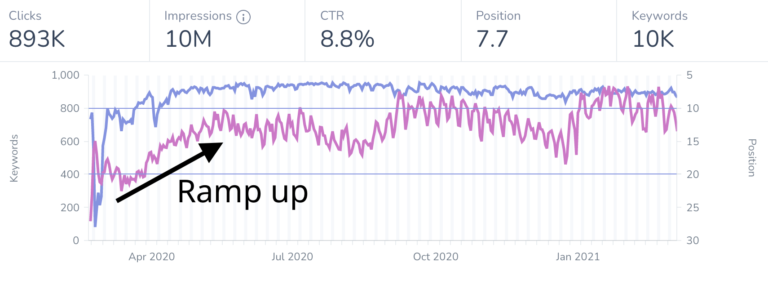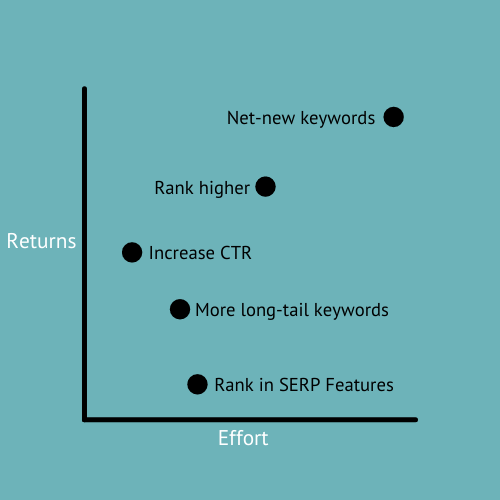It’s easy to get caught up in SEO tactics while forgetting that anything we do – technical SEO, link building, content marketing – has an impact in five ways.
If it drives organic traffic, it follows one of these mechanisms.
When we start with impact in mind, it’s easier to prioritize objectives and tactics.
Everything falls into place.
The goal of understanding these five ways we can drive organic traffic is to flip our thinking from, “What SEO tactics should I apply?” to, “How can I increase traffic through one of these 5 ways?”
1. Rank Higher for Already-Ranking Keywords
One of the easiest and most common ways to drive more SEO traffic is simple: rank better for the keywords upon which you already rank.
We commonly focus on low-hanging fruit and keywords that rank on page two, but all too often forget about pushing keywords from position #4-10 into the top 3.
SERPs follow a power law, meaning the top position is exponentially more valuable than the second one.
The returns from moving a keyword from #2 to #1 are higher than moving it from #3 to #2, which is higher than moving a keyword from #4 to #3.
The higher you rank, the more traffic you get.
This is no news but is often forgotten when it comes to investing resources in SEO.
More traffic comes with larger expectations.
The higher you want to rank, the more checkmarks you need to tick, your content must be of higher value to users, your brand must be more authoritative, and your experience better.
Requirements vary by query.
To understand how to rank higher for a keyword or a set, we need to compare our content and domain on multiple dimensions against the top-ranking result(s).
Sites that scale with inventory, such as social networks or ecommerce sites, should look at patterns of queries that rank on positions #4-10 (or #11-20) and see if they have a common disadvantage against the top results.
2. Rank for More Long-Tail Keywords
Content that already ranks well for its primary keyword can also rank for more and longer-tail keywords to drive more traffic.
Additional keywords content ranks for can be related to the main query, variations, or simply longer and more specific.
Commonly, an increase in ranking keywords can have various reasons:
- The content got more backlinks.
- The content was expanded.
- The content was updated/refreshed.
In each of the three cases, the change indicates to Google that the content is relevant or authoritative for more queries.
3. Rank for Net-New Keywords
Most of the time, we focus on driving organic traffic while forgetting the other four.
While ranking for net-new keywords is arguably the most effective driver of organic traffic, it also takes the most effort.
You can find net-new keywords in several ways:
- Identify keyword gaps with competitors.
- Look for keywords related to the ones you already rank for.
- Think of topics/keywords you don’t cover yet.
- Get suggestions from tools.
Note that it typically takes Google a bit of time to really understand it when launching net-new content.
New content has a “ramp-up time” for unfolding its full potential, during which Google assesses and ranks it higher or for more keywords.
That ramp-up time depends on several factors like the link profile or content quality.

4. Increase Your CTR
Great SEO catches searchers’ attention and fulfills expectations when users click through.
As such, improving your CTR is a low-effort, high-returns option to drive more organic traffic.
We have three basic options to draw more attention:
- Rich snippets.
- Title optimization.
- Description optimization.
Google shows a vast range of rich snippets in its search gallery: site links, FAQ, star rating snippets, and more.
Not every rich snippet has a significant effect and sometimes, it can even be negative.
That’s why testing is the name of the game here!

Not every site can use the full range of rich snippets. Review rich snippets, for example, are mostly reserved for recipe, review, and ecommerce sites.
However, every site can go after certain rich snippets, and every site can optimize titles and descriptions.
Titles, especially, impact multiple dimensions; they draw a lot of attention in the SERPs and have a high impact on relevance and rankings.
The click-through for a query depends on what other SERP Features Google shows.
5. Rank in SERP Features
The Google Search landscape has changed toward an augmented experience aiming to answer questions directly or direct users to the right place beyond 10 blue links.
Websites still get a lot of traffic from Google, but they compete at the same time.
We can control the appearance in such augmentations or SERP Features to a degree. The most obvious opportunity is Featured Snippets, which have become the new #1 spot.
However, there is more.
Other unpaid opportunities you can influence include:
- Image carousel.
- PPA boxes.
- FAQ Snippets.
- Local Packs.
- Top Stories and in-depth articles.
Google’s growing usage of SERP Features drives users to scan search results in a “pinball” pattern rather than the classic F-pattern.
Click-through rates vary and change, depending on what and how many SERP Features Google shows for a query.
That impact is amplified on mobile devices.
Conclusion: Opportunities > Tactics
As SEO professionals, we need to stop looking for the impact of tactics and start looking for the impact of opportunities.
The five fundamental ways to drive organic traffic are great starting points for opportunity sizing, making it easier to get resources because investments are made in potential returns, not tactics.
Each of the five ways has a different ratio of effort vs. returns.
If you’re looking for quick wins you can drive without relying on someone else, CTR improvements are your best bet.
If you’re looking for the biggest possible impact, go for net-new content.

Mind you, not always is change driven by what we do.
As the web grows and evolves, Google constantly indexes new content and weighs it against what’s already ranking.
Google improves its understanding with new breakthroughs in Natural Language Processing (NLP) and Natural Language Understanding (NLU).
Google’s definition of quality isn’t static.
Some algorithm changes can drive more organic traffic to content that hasn’t change simply because Google’s understanding has improved.
More Resources:
- Google Offers Guidance on Featured Snippets Update
- The Importance of Diversification in SEO Strategy
- The Biggest SEO Trends of 2021, According to 42 Experts
Image Credits
Image and all screenshots by author, March 2021





